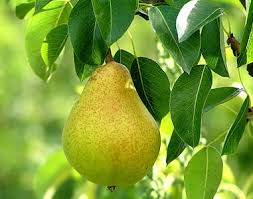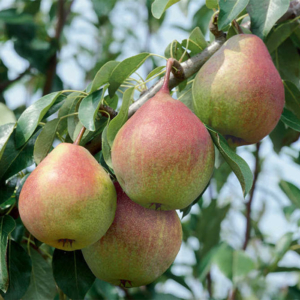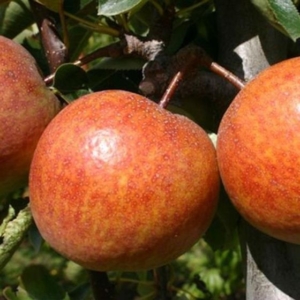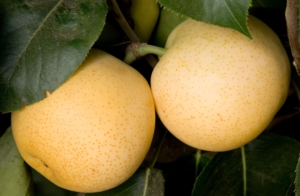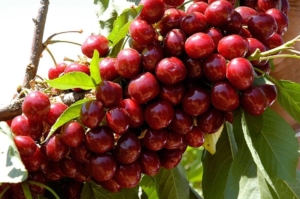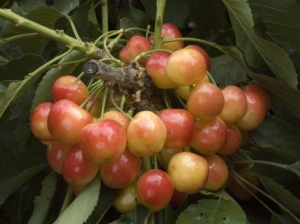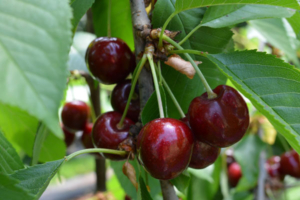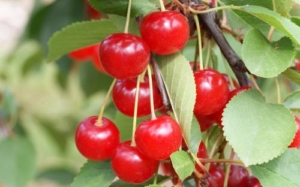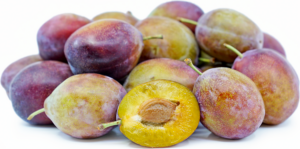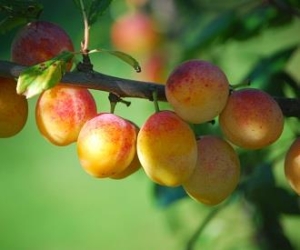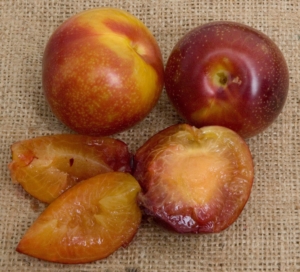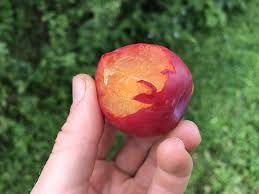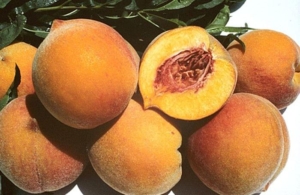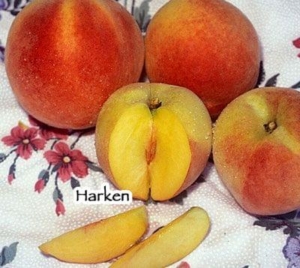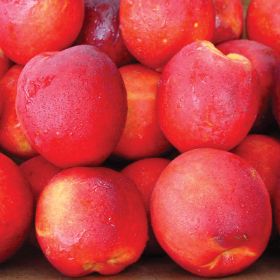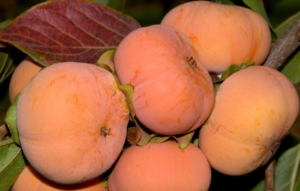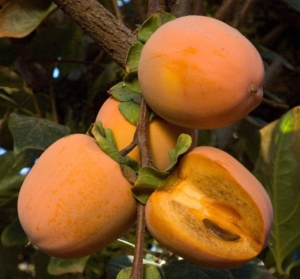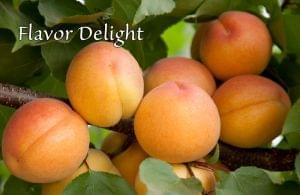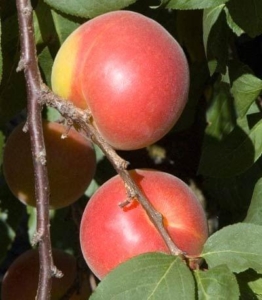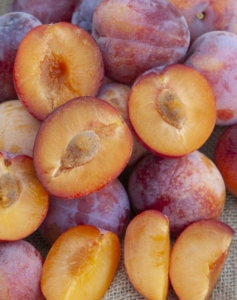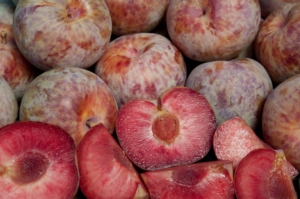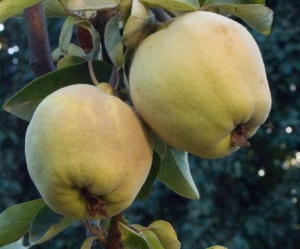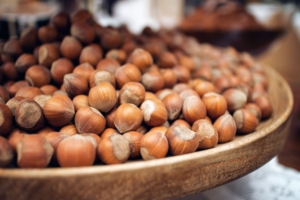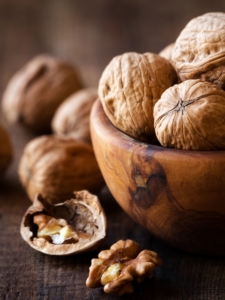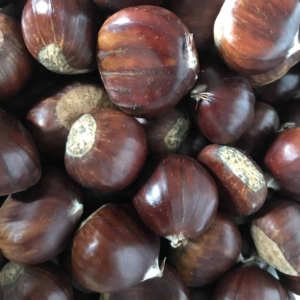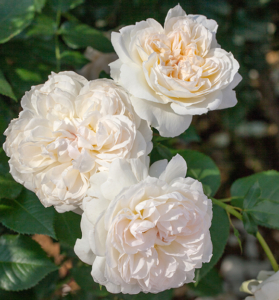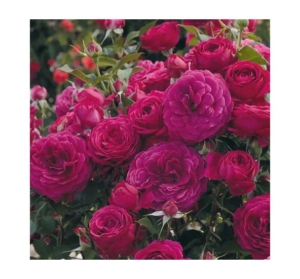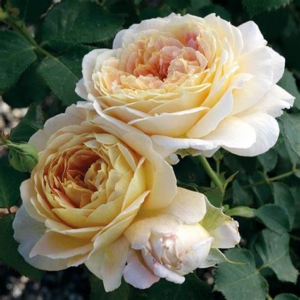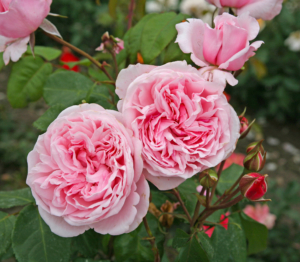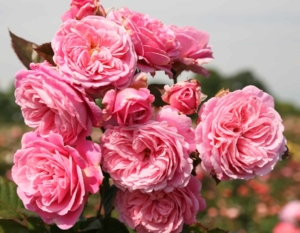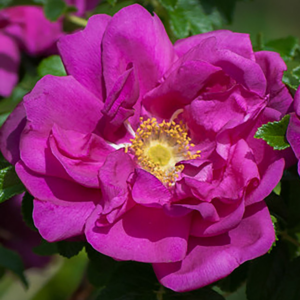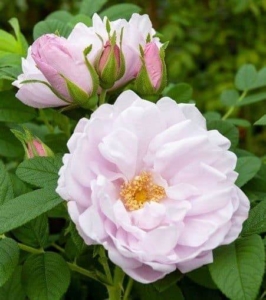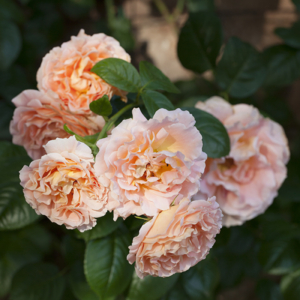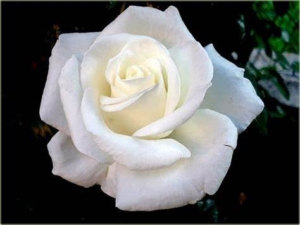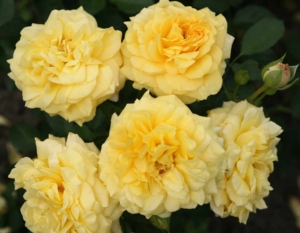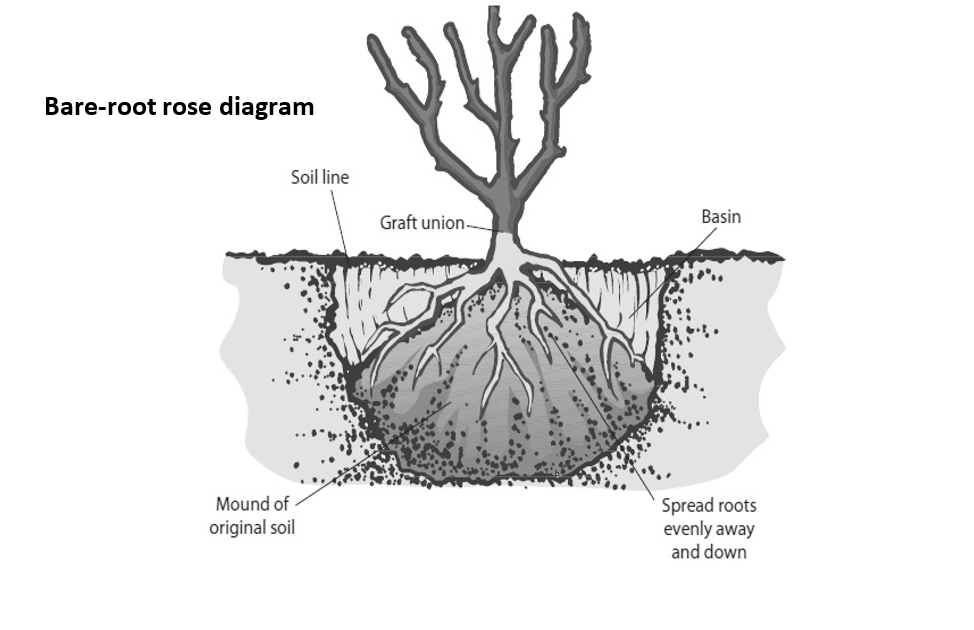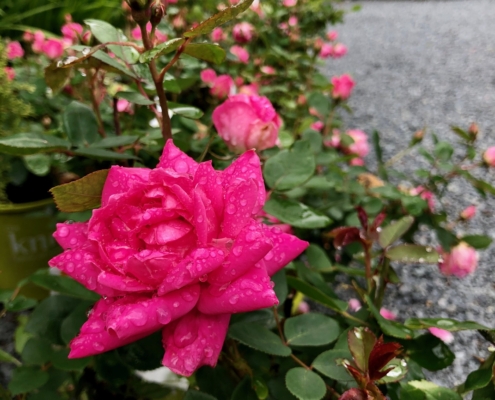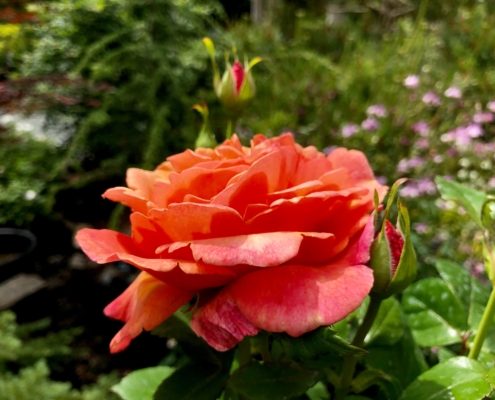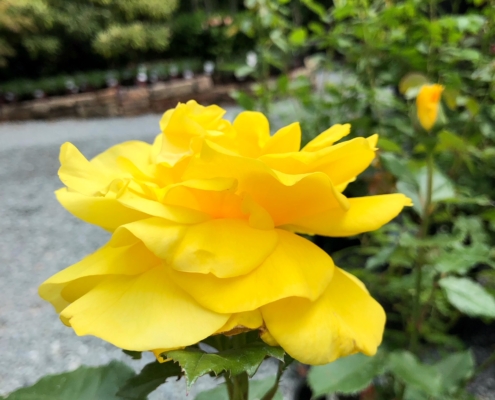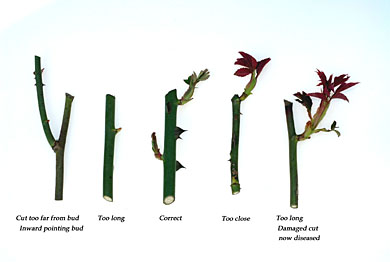Apples for 2025
*Most apples require another apple or crabapple variety to produce fruit. See chart at the end of document for more information.*
Anna: Very early blooming, early ripening and very productive. A Golden Delicious type great for fresh eating or cooking. Sweet, spicy, unusual flavor in a beautifully blushed fruit. Considered partially self-fertile but better with a pollinizer. M7 rootstock.
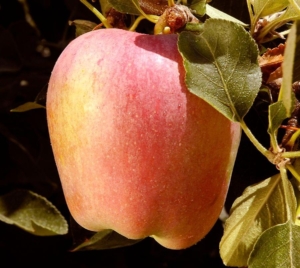
Ashmead Kernal: An English heirloom (1700s!) dessert apple excellent for juicing and cider. Small-medium fruits are green and yellow with golden russet. The flavor is sweet-tart and nutty and improves with storage. Scab and powdery mildew resistant. M106 rootstock.
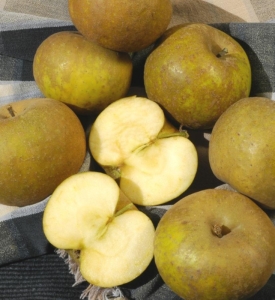
Beni Shogun Fuji: Hailing from Japan, this variety is scab and mildew resistant making it a wonderful choice for organic growers. The fruit is medium-large with orange-red skin and a crisp texture. It has a juicy sweet flavor and a distinctive aroma. While Fujis are considered late to ripen, this variety is the earliest in the group – ready for harvest in mid-September. It is excellent for eating, juicing, and stores well. M27 rootstock.
Braeburn: Developed in New Zealand in the 1950s, the Braeburn is considered a dessert apple: juicy with a crisp texture, and a sharp and refreshing flavor that is sweet without being sugary. The skin is washed in shades of red and green – it was one of the first bi-colored varieties created! A WSU Mt. Vernon recommended variety for the Puget Sound. Matures late, keeps well. M26 rootstock.
Chehalis: This old favorite was discovered north of Chehalis, WA in 1937. This is a large, sweet yellow apple that resembles Golden Delicious in looks and flavor but is crisper and larger. This reliable, highly productive tree is suited for organic growers; it is highly resistant to scab and has good mildew resistance. Fruit ripens in mid/late September. Great for fresh eating and saucing. M26 rootstock.
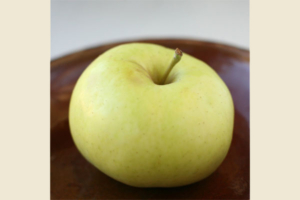
Cosmic Crisp: Developed by Washington State University and released in 2019, this apple is suited to the PNW. Mid to late season bloom, ripens in early October. The flavor is exceptional, both sweet and tart, making it an excellent apple for fresh eating. It is slow to brown once cut, has a long storage life, and holds its flavor well. Red in color with yellow flecks on the skin. M27 rootstock. Not pollinized by Honeycrisp or Enterprise.
Dolgo Crabapple: A great pollinizer for most apples and one of the top choices for making crabapple jelly. Highly ornamental, very disease resistant, and great for wildlife. M111 rootstock.
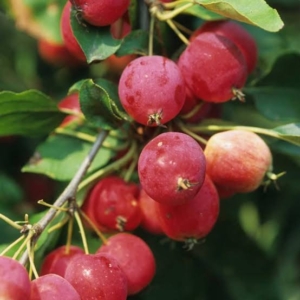
Enterprise: This modern apple is deep maroon. The mildly tart and spicy flavor is good for eating right off the tree. But the flavor and texture improve with storage! Keep this apple for up to 6 months in cool conditions. Apple scab immune and resistant to fire blight. Ripens in early October; holds well on the tree. M26 rootstock.
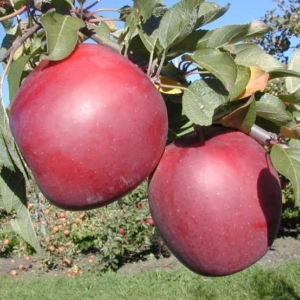
Gala: The most popular apple in the world, a cross between Golden Delicious and Kidd’s Orange Red. This apple has pale golden yellow skin covered by a stripy red blush; flesh is juicy and sweet with hints of vanilla and a floral aroma. This is a great multi-purpose apple suited for fresh eating, juicing and cooking, but not storing. Late blooming, early to ripen. Mildew resistant. M26 rootstock.
Honeycrisp: A modern apple with perhaps the best eating qualities in history. Medium to large, aromatic fruits are red blushed with yellow. Explosively crisp & juicy with a sweet-tart flavor. Excellent for fresh eating, cooking, storing and juicing! Fruit ripens in late September but becomes more flavorful if left on the tree into October. Good disease resistance. A WSU Mt. Vernon recommended variety. Available on either M26 or Geneva 969 rootstock. Not pollinized by Cosmic Crisp.
Liberty: One of the easiest apples to grow, this variety should be included in all Whidbey orchards. It produces a bounty of medium sized, shiny red aromatic apples with yellow overtones. The very juicy fruit has crisp white flesh and a sweet, crunchy texture. Good for fresh eating, baking and cider. Ripens in late September and stores well. Very disease resistant. The tree tends to over-produce; thinning produces better quality fruit. A WSU Mt. Vernon recommended variety. M27 rootstock.
Lucy Gem: Yellow skin is blushed with pink. The flesh is red, with berry notes to the flavor that starts tangy and finishes sweet. A gorgeous addition to your fruit salad! M106 rootstock
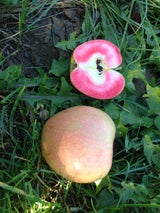
Pristine: Medium sized yellow fruit, crisp and mildly tart. Reliable production and one of the first apples to ripen – in August. Excellent for cooking – saucing and baking – and good for fresh eating too. Good disease resistance. A WSU recommended variety. M26 rootstock.
Sunrise Magic: Developed by WSU, this is a cross between Splendor and Gala. Pinkish-red blush over a yellow background, fruit is firm, crisp and juicy with a bright sweet flavor. Great fresh off the tree and stores well too. Ripens late Sept/early Oct. M26 rootstock.
Espalier: A tiered fruit tree with 3 different kinds of apple varieties grafted to one root stock, ensured to pollinate each other.
Espalier 1: Gala, Honeycrisp, Fuji (on M26 rootstock)
Espalier 2: Akane, Honeycrisp, Liberty (on M26 rootstock)
Apple Rootstock Guide
M106 (EMLA106): Semidwarf, typically 10’ – 13’ tall; tolerant of many soil types except for very wet soils; early production.
Geneva 969: Semidwarf, 50% of standard size so typically 12’ – 15’ tall. High resistance to Wooly Apple aphids and fire blight. Medium resistance to Crown and Root rot. Precocious and productive. Provide adequate drainage.
M7(EMLA7): Semidwarf, unpruned tree height 2/3 of standard, or about 12’-20’. Induces early and heavy bearing, resists fire blight and powdery mildew. Moderately resistant to collar rot. Good anchorage. Very winter hardy. Trees on M-7 may be held to any desired height by summer pruning.
M26 (EMLA26): Vigorous dwarf, about 40 to 45 percent of a standard tree, usually around 12’-15’. Needs some support in early years but could be self-supporting in later years. Very early and heavy bearing. Adaptable for close plantings and double rows.
M27 (EMLA 27): Minidwarf, produces a tree 30 – 50% of the size of the standard, typically around 6’ – 9’. Precocious/early bearing and productive; support recommended.
M111 (EMLA111): Dwarf; unpruned tree height 80-90% of standard. Excellent all-around rootstock for apples. Tolerates wet, dry, or poor soil. Resists woolly apple aphids and collar rot. Induces bearing at young age. Trees on M-111 may be held to any desired height by summer pruning.
Pollination Chart
In general, all apples need to be cross-pollinated by another apple that flowers at the same time. The safest is to choose another variety in bloom at the same time, but typically there is adequate overlap between each neighboring bloom category. For example, Braeburn is a mid-season apple, so while the safest is to choose another cultivar from the mid-season category, it is likely that a type from the early-mid or late season could also be used.
Varieties in *bold are pollen-sterile or triploid and cannot be used as pollinizers.
Certain apples will not be pollinized by cultivars that are in their parentage. For example, Cosmic Crisp is a cross of Enterprise x Honeycrisp so neither will work as a pollinizer.
Any apple in italics is a variety we have sold in the past but are not stocking this year.
| Early | Early-Mid | Mid | Late |
| Anna | Akane | *Ashmead’s Kernal | Beni Shogun |
| *Gravenstein | Dolgo Crabapple | Braeburn | Cosmic Crisp |
| McIntosh | Early Pink Lady | Chehalis | Gala |
| Pink Pearl | Empire | Enterprise | Golden Raindrops Crabapple |
| Zestar | Liberty | Jonamac | Granny Smith |
| McIntosh | *Jonagold | Honeycrisp | |
| North Pole | Lucy Gem | *King | |
| Pristine | Lucy Rose | Spartan | |
| Scarlet Sentinel | Melrose | ||
| Yellow Transparent | *Mutsu | ||
| Thunderchild Crabapple | |||
| Sunrise Magic | |||
| Winter Banana |

